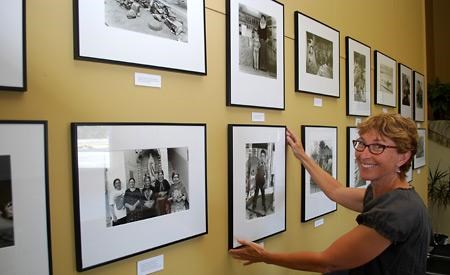It has been said that a picture is worth a thousand words and one English instructor at Vancouver Island University’s [VIU’s] Powell River campus certainly has it in good writing. For much of the spring semester, Wendy Thomas’s students enjoyed daily access to a photography exhibit by world-renowned photographer and poet Carlos Reyes-Manzo, one that took their assignments to new heights and inspired their own works on paper.
Reyes-Manzo’s photos take centre stage in a space that used to be exactly that back in the campus’s former days as an elementary school. In recent months the raised alcove adjacent to the gymnasium has been transformed into an art and meeting space, its walls painted a buttery yellow that makes the Chilean-born artist’s black and white photos come to life.
Although it is summer now, the exhibit will remain on display to the public until at least September and even longer if Thomas has her way. “I’m just going to keep my mouth shut and hope they forget to ask for them back,” she said, laughing. “They” are exhibition coordinator Meg Savory and the exhibition organizing committee at VIU’s main campus in Nanaimo where the photos resided for an extensive period prior to their arrival in Powell River.
Each photo was chosen from a larger body of work, hand-picked by Reyes-Manzo himself and a team from VIU. The exhibit, entitled Rights and Wrongs: The Resilience of the World’s Indigenous People, documents the struggles of aboriginal groups around the world, from South America to South Africa. It’s a subject that Reyes-Manzo has witnessed repeatedly in nearly 50 years as a travelling photojournalist, and one he said bears a common thread wherever he goes.
“I’ve travelled to Canada to different communities and the different first nations there and I’ve seen them very closely, but [those struggles] also happen in other countries,” he said via telephone from his office at Andes Press Agency in London, UK. “My intent is for them and for everybody to see the similarities between the different countries and the different nations around the world.
“In every single country someone is suffering discrimination at this very moment because they are indigenous,” he added, saying he hoped that “people can see that this is the reality behind what can sometimes be very folkloric images of indigenous people.”
Part of the folklore, said Reyes-Manzo, comes from shooting in colour, something he avoids when documenting this type of subject matter. “Colour images can tend to mislead the people,” he said, so instead he captured the exhibit in black and white.
“Black and white is telling you the story and you’re going to read the story and you’re going to understand,” he said. “There’s nothing in between. It’s a very close, intimate relationship between the viewer and the people in the images.”
Thomas said that while all of her students’ responses to the photos were quite profound, the exhibit seemed to especially resonate with the local first nations students in her classes. “Right away they saw the similarities between the indigenous struggles across the world and their own,” she said, “and right away they could see that these [images] represented them too.”
For Reyes-Manzo, that’s the ultimate compliment. “It’s very nice...to know that those students get the idea and feel represented,” he said. “Photography is a very powerful language which can tell stories, very compelling stories, in a very simple way. These stories can go into people’s minds and people’s memories and remain in there.”
And remain they will, even long after the exhibit moves on to its next location.



